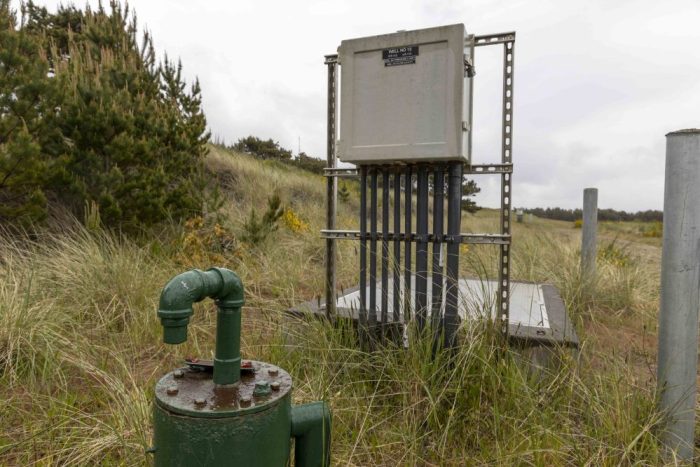The soothing touch helps animals too
Published 5:00 pm Tuesday, August 31, 2004
Astoria woman gets the feel of her new animal massage businessTiny bubbles of spittle formed at the edges of Uda’s mouth. He didn’t notice; his eyes were half-closed and he was too happy and relaxed to be concerned with proper etiquette. He grunted softly and thumped his tail, then yawned, stretched his hind leg and settled back down.
Uda, a 5-year-old mixed breed, was in heaven. He was getting a deep-tissue massage.
Alyssa Grigg grinned as she kneaded the dog’s body. Her fingers were lithe as she worked the muscle beneath Uda’s skin. His owner, Jennifer Kelchner, looked on, impressed.
“We’ve been traveling for four days,” said Kelchner. She and Uda were moving to the Seattle area from Lake Tahoe, Calif., and it had been a long trip for the both of them. “Uda just deserves a little spoiling.”
Uda was getting his massage at the Sunday Market in downtown Astoria from Grigg, who has started her own animal massage business (she’s still thinking of a name). She started the business about a month ago and has slowly built up a list of customers. As well as at the Sunday Market, Grigg massages animals in their homes. As she rubbed Uda, a group of people gathered to watch, some heckling animal massage and others interested in it.
“I expect slow growth, but I still expect the business to go somewhere,” the Astoria woman said. “I think it will be a wonderful business for me.”
BeneficialIt is known in the medical community that massage can be beneficial to humans. Millions get massages every day around the world, and many doctors recommend massage to accompany physical therapy after surgeries or rehabilitative work.
However, animals are rarely thought of as needing massages, even though many dogs and horses are required to perform in sports, agility or obedience competitions, much like humans perform in athletics.
LACEY B. HOYER – The Daily Astorian
Uda has a faraway, overcast look in his eyes as he gets massaged. “I look at it like animals are athletes,” said Missy Fix, a dog breeder and animal massage therapist from Philomath. She’s worked on a range of clients including Seeing Eye dogs and the Hillsboro K-9 police dogs. “You’re asking their bodies to just jump into something. They don’t know how to get their bodies prepared for what they’re going to do.”
Massage provides for animals as it does for humans. Dogs and humans have similar physiology and receive similar benefits from massage, which can increase muscle flexibility, reduce pain in stiff joints and muscles, relieve stress, improve circulation and boost competitive performance. It has been found that with regular massage, animals have a reduced recovery time from injury or surgery. It is also believed that massage can cause an improvement in the fur coat and causes a general improvement in temperament and spirit.
“Animals have a real interesting response to massage,” Fix says. She has worked with more than 100 animals since she began offering massage in 1997. “The animal has never been touched in the way I’m going to touch it. The first time they are a little hesitant. The animals are more receptive the second time and by the third time I come, the dogs are literally throwing themselves on the blanket.
“Once they figure out what I’m doing, they tend to point it out to me, what they want … they understand I’m trying to do good by them,” she continues. The majority of massage is rehabilitative. She sees a lot of animals who need joint work or who have slipped discs. The massage she does keeps toxins moving through the body so they don’t build up, and prevents muscles from atrophying.
Fix encountered the benefits of massage when her miniature dachshund Kia fell, ruptured a disc in her back and lost the use of her hind legs.
“The veterinarian told me she would never walk again without surgery,” Fix says. “It was expensive and I couldn’t afford it, so I began thinking about the hydrotherapy done on horses … I talked with Kia’s vet about it and he told me, ‘It can’t hurt.’
“I bought one of those bathtub spas, and began doing hydrotherapy on Kia. I would work her legs for 20 minutes while she floated on a molded piece of Styrofoam. Once out of the water I would rub her muscles down. After four weeks she was back to normal, and after six weeks I took her to the vet and rolled a ball down the hallway. He was amazed as Kia ran after it.”
Like Fix and Grigg, more and more people are becoming interested in learning and practicing animal massage. Schools and training centers specifically geared toward animal massage therapy are popping up around the nation, including the West Coast.
School foundedThe Northwest School of Animal Massage (NWSAM) was founded in 2001 in response to the growing demand for approved training programs. To earn certification, students must complete 100 hours of rigorous course work and practicums. Students are trained in animal behavior, handling, breeds and disciplines, anatomy, physiology, kinesiology, first-aid, business development and massage theory and practice.
“The veterinarian community is one of the fastest growing sectors of our industry, particularly with small animals,” says Lola Michelin, director of the school. Michelin graduated from Michigan State University with a degree in animal science, and learned animal massage 10 years ago. “Veterinarians are learning about the advantages of massage for their geriatric patients and for animals recovering from surgery … higher standards and better education are key reasons why veterinarians are taking massage more seriously today.”
Animal massage therapy is regarded as highly complimentary to veterinarians, trainers and other animal handlers and the NWSAM has launched a new zookeeper training program to train zookeepers how to massage exotic species.
Michelin says that she is seeing more and more people become receptive toward giving their animals massages, and she believes it is because animals now tend to hold a higher position in families.
“Many animals have the same status in a household as family members and … some animals represent a large investment to their owners (racehorses, showdogs) and so keeping them fit and healthy is a priority,” she says. “Education can be a long process, but nearly every day I hear someone say, ‘I never would have believed how well the massage worked if I hadn’t seen it with my own eyes.'”
It worksGrigg, a recent graduate of the school, graduated earlier from the Cosumnes River College in Sacramento, Calif., earning a degree in veterinary technology, and decided to pursue a career as a veterinary technician.
“I was not fully satisfied with the (veterinary technician) world,” Grigg says. “Veterinary technicians aren’t much appreciated, are paid very little and are not valued. We’re nurses for animals and we were expected to do hard work for little … the vet tech jobs were a little disappointing to be honest.”
Grigg, a slight woman with long brown hair and huge blue eyes, says that there are many fine veterinarians who value their “nurses” and who appreciate the job they do.
“The conventional aspects of medicine weren’t satisfying either,” she says. She was interested in alternative ways of making animals comfortable before during and after surgeries, exams and other medical procedures.
“When an animal was on the operating table, for me it was more, ‘how can I get this animal to relax,'” Grigg says. “I was always more concerned with how the animal was feeling.
“Conventional aspects of medicine are important, but I think that things could be improved to relax animals before and after,” Grigg says. “I enjoy the holistic aspect of working on the whole animal and not just giving it a pill.”
It was this feeling of incompleteness that caused Grigg to find the school. She graduated with a small animal massage therapist certification and decided to open her own business in Astoria, where she has lived for a year and a half.
In addition to dogs, Grigg is trained to massage cats, ferrets, rats and “most other classified and domesticated animals.” She plans to learn techniques to massage birds and is currently studying to become a certified large animal practitioner. She should start taking horses and other livestock as patients in December.
Grigg also plans on studying different techniques of massage and continuing her education. Some of the things she wants to learn include acupressure to utilize her massage moves, Shiatsu and, one day, herbology.
There is a possibility that she’ll branch into human massage, but not anytime soon.
“I really feel that the little furry creatures are better for me … I would like to spend most of my life on the healing touch I can give them,” she says.
Grigg’s massages are $10 for 15-20 minutes at the Sunday Market and about $30 for half an hour and $45 for an hour during house calls.
Judging by Uda’s thumping tail and the grin on his owner’s face, Grigg couldn’t be valued more.
“Oh yes, definitely he enjoyed the massage,” Kelchner says. “How could he not have enjoyed it?”





